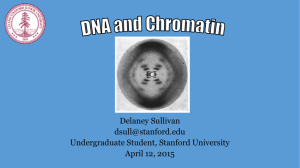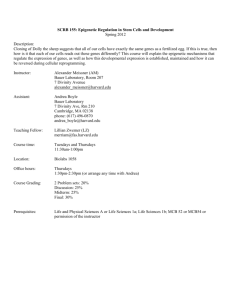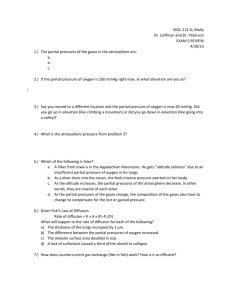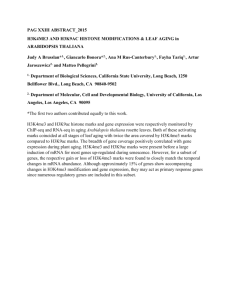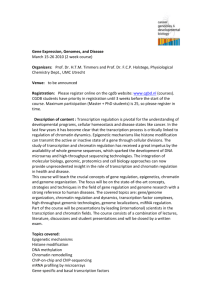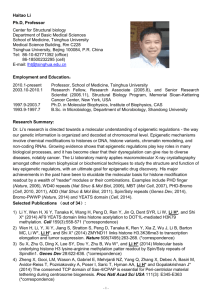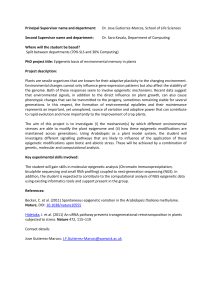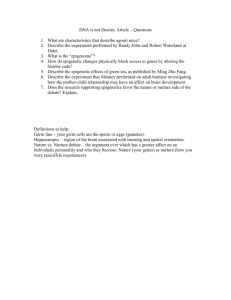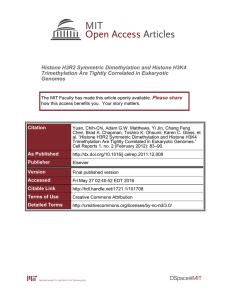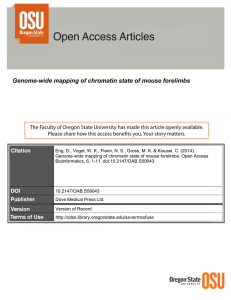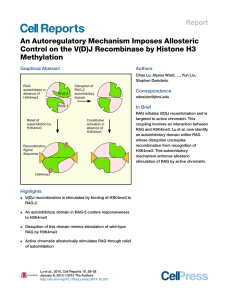4/7/14 - UO Blogs
advertisement
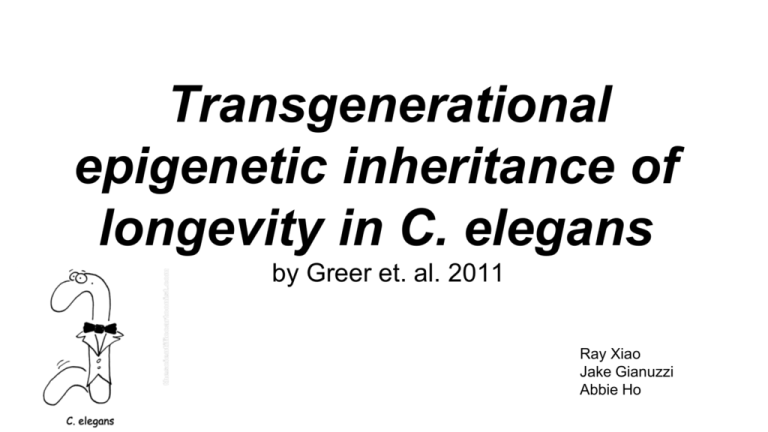
Transgenerational epigenetic inheritance of longevity in C. elegans by Greer et. al. 2011 Ray Xiao Jake Gianuzzi Abbie Ho Important Concepts/Key Terms -C. elegans as a model organism -Brief review of chromatin and histone -’Reprogramming’ the Epigenome -Main purpose of the paper -WDR-5 -SET-2 -ASH-2 C. elegans why is it a good model organism? -relatively inexpensive -remain transparent throughout their life cycle -C. elegans are very fertile -short maturation period -first multicellular organism that has complete sequenced genomes Chromatin & Histone -Chromatin is the combination or complex of DNA and proteins that make up the contents of the nucleus of a cell. -Functions: 1) to package DNA into a smaller volume to fit in the cell 2) to strengthen the DNA to allow mitosis 3) to prevent DNA damage 4) to control gene expression and DNA replication Chromatin & Histone -Histones are the primary protein components of chromatin that compact the DNA -Histones are modified by various post-translational modification to alter DNA packing Reprogramming the Epigenome “..changes in chromatin states in the parental generation could be incompletely reprogrammed in the next generation and thereby affect lifespan of descendants.” -Abstract What is meant by ‘reprogrammed’? -Removal of (most) epigenetic marks established during the development of a mature organism Why is ‘reprogramming’ important (to the organism and its progeny)? -It is important that epigenome-wide reprogramming does not happen during a mature organisms life so that its epigenome is ‘remembered’. -It is important that most epigenetic marks of a mature individual are irrelevant to the next generation, the slate is wiped clean to allow gametic epigenomes to endow the capacity to differentiate into all cell types of a fully developed organism. Objectives What do they study? (What molecule or property of molecules) H3K4me3 in C. Elegans What do they alter experimentally to study this molecule/property? Perturbation of the H3K4me3 regulatory complex (ASH2, WDR5, SET2) only in the parental generation --could it affect longevity of progeny across generations? -The results show that deficiencies in H3K4me3 chromatin modifiers ASH-2, WDR-5, SET-2 in the parental generation extend the lifespan of descendants for several generations. Key Players COMPASS: A heptameric protein complex, consists of SET1: responsible for the bulk of H3K4 methylation - and associated proteins SET2: Histone methyltransferase WDR-5: a conserved regulatory component of ASH-2 ASH-2: a component for the conversion of H3K4me2 to H3K4me3 The Active Mark H3K4me3 is an ‘active mark’, associated with active chromatin, and its excess is detrimental to longevity. How could this be achieved? (i.e. molecular mechanism?) Chromatin modifier WDR-2 Figure 1. Chromatin modifier SET-2 Figure 2. Fig3 How was the ash-2 knockdown different than that of wdr-5 and set-2? -RNAi was usedAny for knockdown, as opposed gene knockout, of ash-2. product’ of ashsuggestions for why to the ‘possible degradation 2 is mostdone abundant in the control P0 organisms? (See 3C) Why was this experiment this way? -Firstly, because it is a viable method for gene suppression in culture and in vivo, and the dropoff in lifespan increase at F4ofrather because synthetic dsRNAWhy can selectively & robustly induce suppression specific genes of interest. than F5 as with wdr-5 and set-2? -Secondly, because ash-2 deletion mutations have been shown ASH2 to be essential, with its mutation resulting in embryonic lethality Fig4 What do Fig4c,d show us? What do Fig4a,b show us? Other Longevity Regulators Effect figure 5 H3K4me3 Expression between mutant and WT figure 6 Some Statistics Hierarchical Clustering - Genes with similar expression patterns are grouped together and are connected by a series of branches Hypergeometric Probability - Drawing without replacement in finite population size. Principal component analysis - Charting a set of observed variables into a set of linear uncorrelated values. figure 6 Possible Mechanisms for Epigenetic Memory Possible Mechanisms for Epigenetic Memory 1. By H3K4me3 alone, loss of epigenetic memory due to H3K4me3 itself expression threshold reached. 2. Other chromatin modifiers marks that are related to H3K4me3. 3.Inherited non-coding RNA that eventually degrades below functional level. 4. Other possible mechanisms? What do you think? Evolution Perspective Can this transgenerational effect of longevity be interpreted as an adaptation? Can you come up with a theory that fits the results of the experiment? Evolution Perspective Consider H3K4me3 is conserved through most organisms, does transgenerational epigenetic memory, in terms of lifespan alteration, apply to other species as well? References Xiao, Yu, Cecile Bedet, Valerie J Robert, Thomas Simonet, Steve Dunkelbarger, Cedric Rakotomalala, Gwen Soete, Hendrik Korswagen, Susan Strome, and Francesca Palladino. 2011. Caenorhabditis Elegans Chromatin-associated Proteins SET-2 and ASH-2 Are Differentially Required for Histone H3 Lys 4 Methylation in Embryos and Adult Germ Cells. Proceedings of the National Academy of Sciences of the United States of America. 108, no. 20: 8305-8310. Greer, Eric, Travis Maures, Anna Hauswirth, Erin Green, Dena Leeman, Geraldine Maro, Shuo Han, Max Banko, Or Gozani, Anne Brunet, and NATURE PUBLISHING GROUP. 2010. Members of the H3K4 Trimethylation Complex Regulate Lifespan in a Germline-dependent Manner in C. Elegans. NATURE. 466, no. 7304: 383. Greer, Eric, Travis Maures, Duygu Ucar, Anna Hauswirth, Elena Mancini, Jana Lim, Berenice Benayoun, Yang Shi, and Anne Brunet. 2011. Transgenerational Epigenetic Inheritance of Longevity in Caenorhabditis Elegans. Nature. 479, no. 7373: 365-371. Benayoun, Berenice, and Anne Brunet. 2012. Epigenetic Memory of Longevity in Caenorhabditis Elegans. Worm. 1, no. 1: 77-81.
